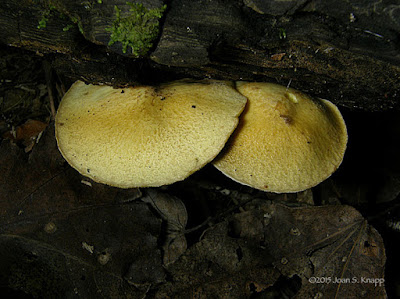September 2nd. When I visited Fort Yargo State Park in mid-February,
there were few signs of Spring. The only wildflower plants that were obvious
were the leaves of Cranefly Orchids (Tipularia
discolor) that I found in many places.
The route… I’ve described it here, here, here, and here. This walk doesn’t have the variety of wildflowers as my other
walk from the Group A Shelter to the Old Fort but it does have some gems. One
of the Smallflower (Asimina parviflora)
had developed fruit that, unfortunately, it had lost; the Pink Lady’s Slipper (Cypripedium acaule) Orchids had bloomed,
and some Green Adder’s-mouth (Malaxis
unifolia) Orchids had bloomed and two were setting seeds. For the moment,
some wildflowers we still blooming but there was a lull between seasons. There
were still some wildflowers blooming but the mushroom season had started in
earnest.
Spurred Butterflypea (Centrosema
virginianum) was blooming near the beginning of the trail. In the absence
of something to climb on, the vines were crawling across the ground.
The Perennial Wildbean (Strophostyles
umbellata) vines were still blooming but had started to develop long, slender seed pods.
By the path, near the beginning of the trail, I encountered
the first of the mushrooms of the day.
The cap on a young amanita mushroom hadn’t opened
completely. I haven’t been able to identify it conclusively. It probably
belongs to the Amanita rhacopus
group; it might be Amanita
texasorora,
and it does resemble this latter species.
Nearby, I found an enchanting cluster of mushrooms that have
been identified by friends in the Facebook Mushroom Identification Form as the
Common Funnel mushroom (Infundibulicybe
gibba;
formerly Clitocybe gibba).
Kudzu (Pueraria
montana) was still blooming, and was already developing…
seedpods.
In the main woods, where I’d found chanterelles in the
summer, I found some different mushrooms now.
The first were members of the genus Suillus. Suillus sp. are
a group of bolete mushrooms with tan-colored caps and pores rather than gills. There
are more than 60 species in the United States; they are divided into five
groups based on whether they grow near hardwoods or conifers; have slimy or dry
caps; have brown glandular spots on their stems; whether their pores are
arranged radially or not; and/or have partial veils that leave rings on their
stems. It can be challenging to identify species of this genus.
I found these Suillus
sp. nestled under a rotting log. They had dry caps, brown gladular spots, pores
that were not arranged radially, and lacked any veil. These were possibly Suillus tomentosus.
On the same log, I found a number of small brown mushrooms
with conical radially striped caps. These were Mycena sp.; this genus has many species and it is very difficult to
identify the species.
An occasional Hairy Elephantfoot (Elephantopus tomentosus) plant was still blooming by the trail.
Bicolor Lespedeza (Lespedeza
bicolor) plants were still blooming along the trail in the main woods.
Tiny mushrooms of Mycena
sp. had fruited on the log at the top of the hill; their caps had opened to form
funnel-shaped caps.
The Coral slime mold, Ceratiomyxa
fruticulosa, had fruited a little further along the same log.
Mold had grown on the fruit of the Tulip Poplar (Liriodendron tulipifera) a little
further along the trail. The mold didn’t seem to be affecting the development
of the fruit.
Some Hairy Elephantfoot plants were still blooming across
the trail from the Tulip Poplar.
Lanceleaf Coreopsis (Coreopsis
lanceolata) were still blooming occasionally at the west end of the dam. A
small crab spider was hunting on this flower.
(To be continued…)
Identification references:
- Mushroom Observer, Walt Sturgeon: Amanita rhacopus
- Mushroom Oserver, Andrew Khitsun: Amanita ‘texasorora’
- Kuo, M. Mushroom Expert.com: Infundibulicybe (Clitocype) gibba
- Kuo, M. Mushroom Expert.com: The Genus Suillus
Related posts:
- Summer On A Fort Yargo State Park Trail: Section
B To The Dam, July 29th (Part 1)
- Spring Is In The
Air: Fort Yargo State Park, Section B To The Dam, May 1st (Part 2)





















No comments:
Post a Comment